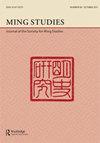Preface
IF 0.3
0 ASIAN STUDIES
引用次数: 0
Abstract
Since the first edition of this book, the field of Body Sensor Networks (BSNs) has advanced rapidly. The original motivation of BSN was to harness allied technologies that underpin the development of pervasive sensing for healthcare, wellbeing, sports and other applications that require “ubiquitous” and “pervasive” monitoring of physical, physiological, and biochemical parameters in any environment without activity restriction and behaviour modification. The ultimate aim of BSN is therefore to provide a truly personalised monitoring platform that is pervasive, intelligent and context-aware, yet “invisible”, with applications ranging from managing patients with chronic disease and care for the elderly, to general well-being monitoring and performance evaluation in sports. To ensure its widespread use, there are many technical challenges that need to be tackled. These include the need for better sensor design, MEMS integration, biocompatibility, power source miniaturisation, low power wireless transmission, context awareness, secure data transfer and integration with smart therapeutic systems. In this second edition of the book, we have updated the chapters with the latest developments in the field, addressing sensor design, micro-electronics and information processing aspects of the system. Since its inception, the development of BSN has been focussed on both wearable and implantable sensors. In the last few decades, we have seen rapid advances in both chemical and biosensor developments. The emergence of new biological sensing modalities is fundamentally changing the way we apply biomeasurements in vivo. In terms of implantable sensing, many of the issues associated with the extension of biosensor technology from in vitro to in vivo applications have long been appreciated, and a number of practical issues are addressed in this book. In a BSN with limited bandwidth and power constraints, the conventional method of data acquisition and analogue-todigital data conversion with signal processing taking place after transmission is no longer optimal. A BSN represents a prime candidate for bio-inspired local processing to take place at the sensor front-end before transmission. This processing前言
自本书第一版出版以来,身体传感器网络(BSN)领域发展迅速。BSN的最初动机是利用相关技术,为医疗保健、健康、体育和其他需要在任何环境中对物理、生理和生物化学参数进行“无处不在”和“无处不在”监测的应用开发普适传感,而无需活动限制和行为改变。因此,BSN的最终目标是提供一个真正个性化的监测平台,该平台具有普遍性、智能性和情境意识,但“隐形”,应用范围从管理慢性病患者和护理老年人,到体育运动中的总体健康监测和表现评估。为了确保其广泛使用,还有许多技术挑战需要解决。其中包括需要更好的传感器设计、MEMS集成、生物相容性、电源小型化、低功率无线传输、上下文感知、安全的数据传输以及与智能治疗系统的集成。在这本书的第二版中,我们用该领域的最新发展更新了章节,涉及传感器设计、微电子和系统的信息处理方面。自成立以来,BSN的发展一直集中在可穿戴和植入式传感器上。在过去的几十年里,我们看到了化学和生物传感器的快速发展。新的生物传感模式的出现正在从根本上改变我们在体内应用生物测量的方式。就植入式传感而言,与生物传感器技术从体外应用扩展到体内应用相关的许多问题早已得到重视,本书中讨论了许多实际问题。在带宽和功率受限的BSN中,在传输后进行信号处理的传统数据采集和模数数据转换方法不再是最佳的。BSN代表了在传输之前在传感器前端进行生物启发本地处理的主要候选。此处理
本文章由计算机程序翻译,如有差异,请以英文原文为准。
求助全文
约1分钟内获得全文
求助全文

 求助内容:
求助内容: 应助结果提醒方式:
应助结果提醒方式:


